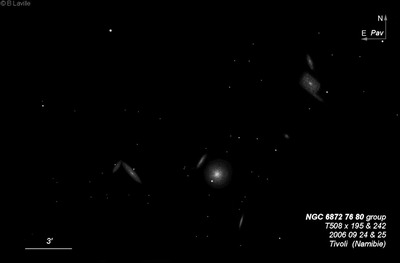
In 1979A&A, 79, 22, the abstract for "NGC 6872 - A remarkable barred spiral" states, "The extent of the arms is probably greater than in any other spiral known; it is concluded that NGC 6872 is a conventional barred spiral in which severe tidal interaction took place."
John Herschel discovered NGC 6872 = h3816 on 27 Jun 1835 and recorded "F; R; glbM; 30"; has a vS * preceding. first of 4 [with NGC 6876, 6877 and 6880]." On a second observation he called it "F; E; 40" l; has a * 9m 10.5 seconds preceding."
Joseph Turner discovered nearby IC 4970 on 27 August 1881during an observation of NGC 6872 with the Great Melbourne Telescope.
400/500mm - 18" (7/10/02 - Magellan Observatory, Australia): second brightest in the Pavo-I Group with brightest member NGC 6876. Moderately bright, fairly small, elongated 2:1 SW-NE in the direction of a mag 10.4 star 1.1' WSW of center, ~1.2'x0.6', broad concentration with a brighter core. Interacting with IC 4970 at 1.1' N just outside the halo while fainter PGC 64439 lies 4.0' SE. Other members of the group include NGC 6876, NGC 6877, NGC 6880. IC 4970 appeared faint, very small, slightly elongated, 20"x15". Images reveal a distorted bridge and plumes due to interaction with NGC 6872. PGC 64439, nearly at the midpoint of NGC 6872 and NGC 6876, appeared very faint and small, round, 0.3' diameter, low surface brightness.
18" (7/8/02 - Magellan Observatory, Australia): moderately bright, elongated 2:1 SW-NE towards a mag 10.5 star off the SW edge, 1.2'x0.5'. Fairly well concentrated with a small bright core.
600/800mm - 30" (10/13/15 - OzSky): NGC 6872 is a remarkably stretched spiral with extremely distended arms spanning roughly 750,000 light years. At 303x it appeared very bright, fairly large, elongated 5:3 SW-NE, 1.2'x0.7', sharply concentrated with a bright core encasing an extremely bright nucleus. A mag 10.4 star is off the west side of the halo, just 1.1' WSW of center. The initial portions of the spiral arms are visible as thin, very low surface brightness wings, extending ~1' southwest on the south side and northeast on the north side. The tidal extensions were not seen. A mag 13 star lies 2.4' ENE. IC 4970, an interacting companion 1.1' N of center, appeared fairly faint to moderately bright, fairly small, slightly elongated N-S, 0.4'x0.25', contains a very small bright nucleus.
Notes by Steve Gottlieb